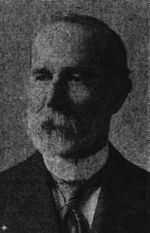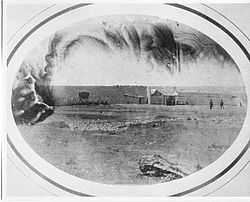Samuel C. Mills

A photographer from Washington, D.C., Samuel C. Mills produced the earliest surviving photographic record of the Oregon Trail and California Trail, from Fort Leavenworth, Kansas Territory, to Camp Floyd, Utah Territory.
Early years
Born October 8, 1833 in Washington, D.C., Samuel C. Mills was the son of John and Mary Mills. As a young man, he worked in his father's shoe factory. In 1856, he became an apprentice in the photography studio of Blanchard P. Paige in D.C. By 1858, he was working in a studio on Pennsylvania Avenue.[1]
Simpson Expedition, 1858-59

In 1858, Captain James H. Simpson, an officer in the Army's Topographical Engineers, was assigned to the reinforcements being sent to Utah Territory as part of the so-called Utah War.[2] He hired Samuel Mills as the photographer for his expedition. They departed Fort Leavenworth on May 31, 1858 and headed west, with Mills producing photographs along the way. His surviving images include photographs of Fort Leavenworth, Fort Kearny, Fort Laramie, Devil's Gate, and Fort Bridger.[3]
After arriving at Camp Floyd, Mills accompanied Simpson's detachment in surveying a new road to Fort Bridger up Provo Canyon. Upon their return, the photographer then made a series of negatives of Camp Floyd to illustrate the nature of the post.
In May 1859, Captain Simpson set out on his famous exploration across the Great Basin of present Utah and Nevada.[4] The available evidence suggests that Samuel Mills remained behind. Upon Simpson's return, they departed Camp Floyd heading back east to write their survey reports. Mills arrived back in Washington, D.C. in the fall of 1859.
Later History
Samuel Mills continued work as a photographer for several years in Washington, D.C. following his return from the Simpson Expedition. He married about 1861 and during the Civil War, served as a hospital steward. Later, he studied law and was admitted to the bar in Washington in 1872. He was soon afterward appointed as a police court judge, a position he held until his death. In later life, he was an active member of the Grand Army of the Republic and the Masons. He also founded a temperance organization known as the Sons of Jonadab. Samuel Mills died on October 7, 1911 and was buried in the Congressional Cemetery in Washington, D.C.[5]
Notes
- ↑ Washington Post, Oct. 15, 1905
- ↑ Barbara Beeton, "James Hervey Simpson in the Great Basin," Montana the Magazine of Western History (Winter 1978) pp. 28-43.
- ↑ Simpson, in his privately published book The Shortest Route to California (Philadelphia: J. B. Lippincott & Co., 1869) p. 32 gave the name of the photographer as C.C. Mills. However, this was apparently a typographical error as shown in his original handwritten correspondence.
- ↑ Jesse G. Petersen, A Route for the Overland Stage: James H. Simpson's Trail Across the Great Basin (Logan: Utah State University Press, 2008).
- ↑ Washington Post, Oct. 9 and Oct. 11, 1911.
Bibliography
Ephriam D. Dickson III, "On the Trail of Captain Simpson's Illusive Photographer, 1858-59," The Fort Douglas Vedette, v. 34 no. 2 (Summer 2009) pp. 4–6.